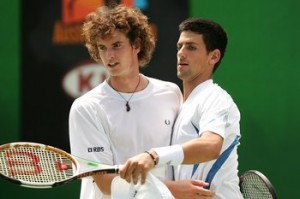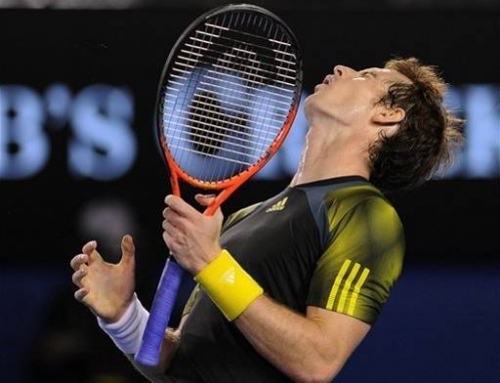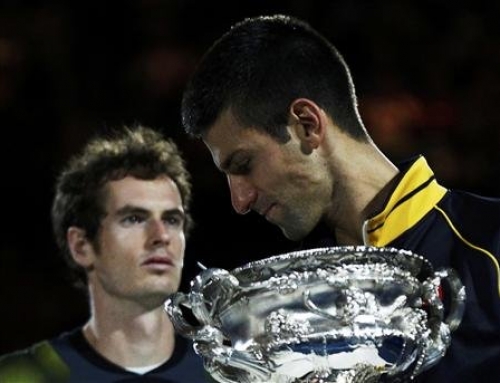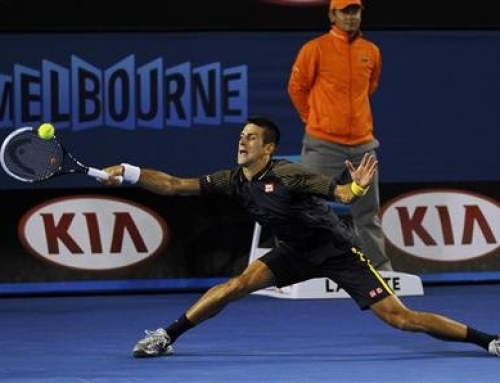 Roger and Rafa have made many players’ lives miserable. That is, if you feel the best of the best should win Slam titles. The 2008 Australian Open was the last Slam that didn’t have either Roger or Rafa in the final. Roger lost to Novak Djokovic in the semifinals. Roger had had mono and was arguably not on the top of his game, something that affected him all year, although he did manage to reach every Slam final that year.
Roger and Rafa have made many players’ lives miserable. That is, if you feel the best of the best should win Slam titles. The 2008 Australian Open was the last Slam that didn’t have either Roger or Rafa in the final. Roger lost to Novak Djokovic in the semifinals. Roger had had mono and was arguably not on the top of his game, something that affected him all year, although he did manage to reach every Slam final that year.
Rafa lost to Jo-Wilfried Tsonga, a French upstart that used an attacking style mixed with deft touch to surprise the Mallorcan. Where was Andy Murray in this mix? Guess who Tsonga beat in the first round? Andy Murray.
Djokovic won his only Slam in that Australian Open. In a way, it was a bit lucky for Djokovic. Tsonga had never been in a Slam final while Djokovic had reached the 2007 US Open final. However, Djokovic still had to beat Federer, but he was lucky there in that Federer wasn’t 100%. Still, take nothing away from Djokovic. It’s not like he didn’t play the number 1 player at the time. He did avoid playing the number 2 player in Rafa.
Murray’s rise wouldn’t begin until the summer. He was already in the top ten at the start of 2008. He had just started working with Miles Maclagan and the rest of his team of Jez Green and Andy Ireland. Murray had parted ways with Brad Gilbert, something other pros, like Andy Roddick had done. Gilbert was considered too in-your-face and way too chatty. It’s amazing how patient Andre Agassi was with Gilbert.
Murray knew that his fitness was hurting him in matches. He would look dominant then simply fade, unable to play at full force, lacking the energy needed. It took about 6 months before the fitness took effect. Murray’s big breakthrough was a pair of wins during the summer circuit, just before the US Open. Murray beat Djokovic in Toronto in the quarterfinals, then beat Djokovic again in Cincinnati. Murray would end up losing to Yen-Hsun Lu in the first round of the Olympics, but it may have been a blessing in disguise.
Murray came back to the US and pulled his biggest upset. He beat Rafael Nadal in the semifinals that spread out over 2 days. Everyone felt the second day would favor Nadal. Indeed, Nadal won the third set, but Murray continued hammering at Nadal and upset him to reach the US Open final. It would be the second year in a row that Roger Federer would meet an upstart in the finals. And Roger Federer would win the US Open over Andy Murray as well.
Both Murray and Djokovic would win plenty of titles in 2009, but neither would reach the finals of a Slam. Murray reached the Wimbledon semis for the first time, but lost to Andy Roddick, for his best Slam result in 2009. Djokovic would reach the semifinals of the US Open for his best 2009 result.
The two men, born only a week apart, had similar 2010 seasons. Andy Murray reached his second Slam final meeting Roger Federer for a second time. Murray hoped to outrally Federer, but Federer was feeling his strokes that day. By the time Murray adjusted his tactics in the third set and pushed the match to a tiebreak, he was unable to force a fourth set and Federer was again holding another trophy.
Novak Djokovic would also reach a Slam final. The US Open has been Djokovic’s best Slam, despite not winning there. He’s reached the semifinals twice and the finals twice. Djokovic upset Roger Federer in the semifinals with Federer holding match points. Djokovic hit huge shots to win that match. But the match was so wearying, that even with a Monday final, Djokovic could not do much to prevent Nadal from completing the career Slam.
It was not clear who was the favorite heading into the Australian Open this year. The player most in form was, of course, Roger Federer. He had won the year-end championship. He beat Davydenko to win Doha. He said he was ready. Meanwhile, Rafa had some kind of fever that impacted his play in Doha, but everyone figured, as the holder of the last 3 Slams, Rafa was going to be co-favorite. And because Roger and Rafa had dominated proceedings in the Slams for so long, Murray and Djokovic were given some chance, but were expected to lose to the top players.
Once the tournament started, the top seeds started off well. Then, Roger stumbled. Former top ten player, Gilles Simon, pushed Roger to 5 sets. Tommy Robredo took a set off of Roger. Even his victory over Xavier Malisse looked a bit rough, despite a straight set score. He steamrolled over Wawrinka, but there was doubt whether Federer was ready.
Meanwhile Djokovic cruised through his first few rounds, dropping a tight tiebreak to Ivan Dodig, before easily winning sets 3 and 4. The two wins that made everyone think he was in solid shape were the straight set wins over Almagro and Berdych. Berdych had come off a beatdown of Verdasco, and many thought Berdych, who had played meh tennis after Wimbledon was now back in top form. Djokovic made short work of Berdych.
Then, of course, Djokovic beat Roger Federer. Although both players started off hitting quite well, Federer’s strokes looked a bit flat in the second set, despite a 5-2 lead. Federer was leaving balls short and in the center of the court. Even when Federer could get a nice line shot or a nice crosscourt, Djokovic was chasing them down. Worse still, Federer was not winning many free points on serve. When Federer’s game hums, he wins his service games in a minute. Djokovic was making Roger hit lots of balls and Roger was growing conflicted. Go for a big shot, and see Djokovic get it back anyway, or play patient, and then get pushed around.
Andy Murray’s early rounds were surprisingly easy. Even so, Murray’s game always looks tortured enough that he appears to struggle even when he is winning handily. His first challenge was expected to be Guillermo Garcia-Lopez, the 32nd seed. Garcia-Lopez had beaten Nadal in Bangkok last year. Nope, he beat the 32nd ranked player like he was a qualifier. OK, tough lefty, Jurgen Melzer, playing the best tennis of his life, would give Murray trouble. Nope, only 5 games lost to the 11th ranked player in the world.
One must recall that Murray was seeded fifth, not fourth. Robin Soderling, nipping at Murray’s heels, won Brisbane (which was starting to flood) and picked up enough points to be fourth in the world. Murray was lucky to draw Soderling, and in effect, could feel like the fourth seed. Except, of course, if Murray had been the fourth seed, Soderling would have had a 1 in 4 chance of meeting Murray in the quarters. Murray could have faced Berdych, Ferrer, or Roddick instead.
As everyone knows, the Soderling thing didn’t happen. Until Dolgopolov beat Soderling, the thinking was that Soderling had a shot, as he does in most Slams, to go deep. He had won his previous rounds without dropping a set. Dolgopolov is talented, to be sure, but surely, Soderling’s power would be too much. And for a few sets, it was. But Dolgopolov was able to direct balls to far corners away from Soderling’s reach. By the end, Soderling looked as defeated as he did against Nadal at the French.
As dangerous as Dolgopolov is, he entered the tournament unseeded. He gave Andy Murray all he could handle. Murray was pulling out his bag of tricks. Squash shot forehands. Sliced lobs. And hoping Dolgopolov would produce enough errors so Murray could eke out the win. Still, this was seen as something of a weakness. Djokovic hadn’t been pushed to a fourth set after Dodig. Meanwhile, Murray lost a set in the quarterfinals.
Then, Murray had something of a blessing. Seeded to meet Rafa, he didn’t play Rafa either. Bad news for Rafa. Hamstring injury. Of course, Ferrer couldn’t feel sorry for Nadal. He still had to win. Although Ferrer had been playing low-ranked upstarts, he had won Auckland, and generally makes you work for every point. Ferrer knew what a golden opportunity this was. Ferrer had played some 32 consecutive Slams and only twice reached the quarterfinals and only once reached the semifinals (2007 US Open). A player of Ferrer’s caliber generally only gets one chance to reach a Slam final and the Australian Open has been the site of many such players (Tsonga, Johansson, Baghdatis, Clement, Rainer Schuettler).
Ferrer was the whipping boy in Group B at the ATP World Tour Finals at the end of November. He lost to Federer, Soderling, and Murray. Murray won 6-2, 6-2.
But Ferrer had beaten Murray three times, including twice in 2010, admittedly on clay. Ferrer had been playing very good hardcourt tennis starting in Beijing (getting to the finals, losing to Djokovic), then winning Valencia, and of course, Auckland, a few weeks ago.
Ferrer took the first set against Murray. Despite a late break, Murray could not serve out the second set. Ferrer broke back, before Murray dominated the tiebreak. Murray steamrolled in the third set, and broke early in the fourth set. Ferrer would even it up, and they would head to tiebreak where Murray would again dominate and win in 4 sets.
This match was a bit rough on Murray for a few reasons. In the Australian Open, they split the men’s semifinals. One semis gives 2 days of rest to the winner and the other only gives 1 day. Murray was in the semi that only gave 1 day of rest. And, he had the tougher match. Admittedly, in 2009, Nadal found himself in a worse situation (a long 5 setter) and still won the tournament.
Djokovic goes into the finals as a slight favorite because he beat Roger Federer. Murray didn’t have to play Rafa to reach the finals. This hasn’t hurt Murray before. In Shanghai, Roger Federer beat Novak Djokovic, while Murray only had to beat Juan Monaco (he beat Tsonga in the quarters, but Tsonga was just returning back to tour after injuries). He still beat Federer in the finals.
Djokovic also beat two bangers in Berdych and Federer. Although Murray has improved his power, he doesn’t use power the way Berdych or Federer does. Djokovic was able to neuralize Federer by returning serve well. Federer needs a few free points a game to be humming. Murray, on the other hand, often has a low first-serve percentage. This even happens in matches he wins handily. Murray beat Ferrer 6-2, 6-2 back in London with a 45% first serve percentage. This may negate Djokovic’s return of serve. Federer often expects to get a jump after his first serve. When Djokovic robbed him of this, the two played on more even terms.
Off the ground, Djokovic is the steadier of the two. He’s more willing to hit down-the-line. But Murray has been spending the last few months honing the down-the-line shot and beefing up his forehand. To beat Ferrer, Murray closed in tight to the baseline, something that goes against his instincts. Will he do the same with Djokovic?
Murray also wins when you think he won’t. He has a resilience that is surprising. There seems to be plenty of players that hit harder than Murray, and yet Murray often ends up winning those matches just fine.
The famous Melbourne heat, which was mostly missing the entire tournament, is expected to be back on Sunday. However, the match is played at night. Djokovic also played in hot Perth in the Hopman Cup and didn’t seem the worse for wear. Even if the heat doesn’t affect Djokovic, both players will like the ball flying a bit faster.
On form, I’d give Djokovic the slight edge. However, Murray needs this win more than Djokovic. Djokovic not only has his one Slam, but he recently came off a Davis Cup win, something Murray can’t even come close to imagining without a significant UK number 2. He’s had two losses so far. Has he learned the lessons to push him to victory?
This has the makings of an exciting match.






![[Aussie Open Final] Can Andy Murray beat Novak Djokovic?](https://www.essentialtennis.com/wp-content/uploads/2013/01/20130126andy-500x383.jpg)
![[Day 13, Aussie Open] Bryan brothers win 13th Slam with Aussie doubles title, Kyrgios wins boys title](https://www.essentialtennis.com/wp-content/uploads/2013/01/20130125bryan-500x383.jpg)